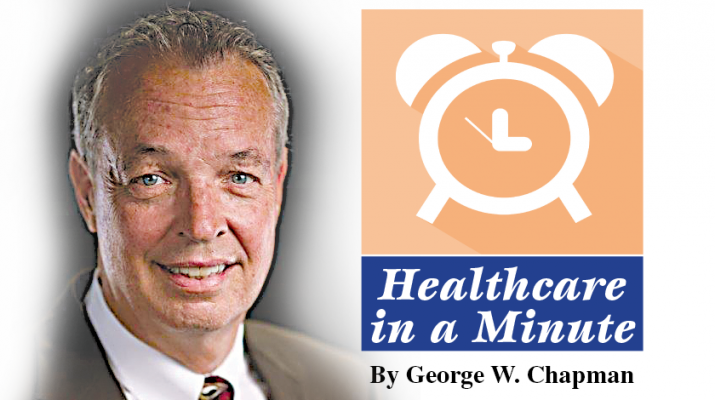By George W. Chapman
No one could have predicted that a pandemic would be the catalyst or “black swan” event for telehealth.
Up until the pandemic, telehealth was infrequently used. It was approximately 10% of a typical provider’s schedule in 2019. In April 2020, it had ballooned to 46%. Industry experts are predicting that telehealth could be $250 billion a year in spending post-pandemic.
Both providers and consumers are adapting to the new reality. According to a recent consumer survey by McKinsey & Company, 75% of respondents are highly or moderately likely to use telehealth services. Seventy-five percent of respondents who recently received services via telehealth were satisfied. Up until the pandemic, providers were somewhat reluctant to incorporate telehealth into their business models, primarily due to poor reimbursement from insurers.
Telehealth was used mostly to reach isolated, rural or homebound patients. Because of the pandemic, Medicare began to reimburse providers for a telehealth visit the same as an office visit. Most commercial carriers followed suit. Healthcare facilities and business establishments in San Francisco, CA may click now if they need to install audiovisual systems to conduct telehealth or video conferencing.
The big question is whether or not Medicare will continue improved telehealth reimbursement beyond the pandemic. The longer this pandemic lasts, the further the horse is out of the barn. Medicare would certainly face a backlash from both providers and consumers who have adapted to this delivery of care option. Centers for Medicare and Medicaid Services (CMS) Administrator Seema Verma sounds like she is hedging her bets, though, when she said that while telehealth is getting us through this pandemic, it won’t replace the “gold standard” of in-person care.
AHA Addresses Systemic Racism
The pandemic has disproportionally impacted people of color. It has exposed the systemic racism in public health. Rick Pollack, CEO of the American Hospital Association, recently addressed the problem. “As places of healing, hospitals have an important role to play in the wellbeing of their communities. As we’ve seen in the pandemic, communities of color have been disproportionately affected, both in infection rates and economic impact. The AHA’s vision is of a society of healthy communities, where all individuals reach their highest potential for health … to achieve that vision, we must address racial, ethnic and cultural inequities, including those in health care, that are everyday realities for far too many individuals. While progress has been made, we have so much more work to do.”
COVID19 Vaccine
Dr. Tony Fauci is the nation’s leading expert on infectious disease. As director of the National Institute of Allergy and Infectious Diseases, or NIAID, Fauci is cautiously optimistic about the development of a vaccine by bio tech firm Moderna. However, he believes the vaccine will not be a one and done solution and will most likely require boosters. Once a vaccine is approved for use, the question remains what will be its durability. It could be six months or a year or two. (It should be noted: Moderna is not the only bio tech firm developing a vaccine.) There has been much confusion over wearing masks. Fauci emphasized the three basics of mitigation are still the most effective at slowing the spread of the virus: frequent hand washing, social distancing and masks in public. The latter all the more important when inside. Meanwhile, in anticipation of a vaccine, the federal government has begun stockpiling 400 million syringes by December.
What We Know So Far
A recent article in the New York Times gave a summary. 1) We will be dealing with this pandemic for a long time. 2) Masks mitigate the spread. 3) Our public health infrastructure needs an update if not an overhaul. 4) The pandemic is hugely expensive: testing, treatment, PPE, lost wages, mitigation, etc. 5) We can’t count on herd immunity to protect us. 6) There are far more symptoms than expected or experienced. 7) We can worry less about surface transmission of the virus. It is mostly person to person. 8) We can worry less about a mutating virus. 9) Warm weather will not defeat the virus. Estimates of the cost of the virus to insurance companies, (commercial, Medicare Advantage and Medicaid) are modeled or based on infection rates. A population infection rate of 10% puts cost estimates around $30 billion while an infection rate of 60% could cause costs to skyrocket toward $500 billion.
Reopening Healthcare
The pandemic forced hospitals and physician offices to close to non-emergent care. The cancellation of elective surgeries and routine office visits have put most providers in dire financial straits. Most have resorted to furloughing or laying off staff as bottom lines flounder. In April, CMS issued guidelines for providers to open up again for normal business. Basically, “non-emergent, non-COVID care (NCC) should be offered to patients, as clinically appropriate, in localities or facilities that have the resources to provide such care, as well as the ability to quickly respond to a surge in COVID-19 cases, if necessary. Decisions should be consistent with federal, state and local orders, and CDC guidance and made in collaboration with state and local public health authorities. Careful planning is required to safely deliver in-person care to patients requiring NCC, and all aspects of care must be considered.” If you have been putting off care, you are encouraged to contact your provider and resume your treatment or address your health concerns.
CVS Testing NURO
If pizza can be delivered via drone or autonomous vehicle, why not drugs? CVS pharmacy is currently testing delivering prescriptions via autonomous vehicle “NURO” in a Houston suburb. NURO is a business that started in 2018 delivering groceries in Texas and Arizona. The company raised over $1 billion from investors.
George W. Chapman is a healthcare business consultant who works exclusively with physicians, hospitals and healthcare organizations. He operates GW Chapman Consulting based in Syracuse. Email him at gwc@gwchapmanconsulting.com.

